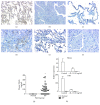TRAIL-Dependent Resolution of Pulmonary Fibrosis
- PMID: 29670467
- PMCID: PMC5833466
- DOI: 10.1155/2018/7934362
TRAIL-Dependent Resolution of Pulmonary Fibrosis
Abstract
Idiopathic pulmonary fibrosis (IPF) is the most common form of interstitial lung disease characterized by the persistence of activated myofibroblasts resulting in excessive deposition of extracellular matrix proteins and profound tissue remodeling. In the present study, the expression of tumor necrosis factor- (TNF-) related apoptosis-inducing ligand (TRAIL) was key to the resolution of bleomycin-induced pulmonary fibrosis. Both in vivo and in vitro studies demonstrated that Gr-1+TRAIL+ bone marrow-derived myeloid cells blocked the activation of lung myofibroblasts. Although soluble TRAIL was increased in plasma from IPF patients, the presence of TRAIL+ myeloid cells was markedly reduced in IPF lung biopsies, and primary lung fibroblasts from this patient group expressed little of the TRAIL receptor-2 (DR5) when compared with appropriate normal samples. IL-13 was a potent inhibitor of DR5 expression in normal fibroblasts. Together, these results identified TRAIL+ myeloid cells as a critical mechanism in the resolution of pulmonary fibrosis, and strategies directed at promoting its function might have therapeutic potential in IPF.
Figures






References
MeSH terms
Substances
LinkOut - more resources
Full Text Sources
Other Literature Sources
Medical

